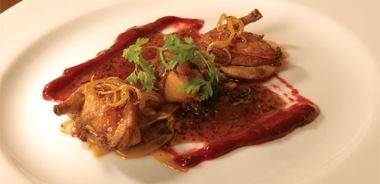Honey Glazed Quail with Fennel Salad and Cranberry/Chestnut Marmalade

Creative flair and familiar flavours combine to create an accessible and delicious alternative to more traditionally festive fowl.
Quail
6 semi-boneless quails
2 lemons, zested
1 Tbsp (15 mL) extra-virgin olive oil
1 tsp (5 mL) black peppercorns, ground
2 Tbsp (30 mL) butter
2 Tbsp (30 mL) blackberry honey
2 sprigs fresh thyme
Salt, to taste
Lay quails flat onto cutting board, skin side down. Drizzle with olive oil, then rub in lemon zest and pepper. In a thick-bottom pan at medium to low heat, add a small amount of oil, then place the quails skin side down. Sauté until skin becomes crispy (about 7 minutes).
Once crisped, add butter, honey, and thyme. Flip quails over and baste for 45 seconds. Serve.
Fennel Salad
2 bulbs fennel, shaved finely on mandoline slicer
2 shallots, minced
1 clove garlic, mashed
1 tsp (5 mL) fennel seed, toasted and ground
1 tsp (5 mL) sea salt
2 lemons, juiced
1 Tbsp (15 mL) extra-virgin olive oil
1 tsp (5 mL) chili flakes
Combine all ingredients in a salad bowl. Toss together until well mixed. Wait 5 minutes before you serve to allow fennel to wilt slightly.
Cranberry and Chestnut Marmalade
1 cup (250 mL) fresh cranberries
2 cups (500 mL) cranberry cocktail
1 orange, zest and juice separated
1 cup (250 mL) white wine vinegar
1 cup (250 mL) sugar
1 cup (250 mL) canned unsweetened chestnuts, roughly chopped
2 cups (500 mL) dried cranberries
In a large-mouth pot add fresh cranberries, cranberry cocktail, orange juice, vinegar, and sugar. Reduce by two-thirds or until thin syrup consistency. Add the rest of the ingredients and mix together. Serve warm or cold.
Serves 6.
source: "Make This Holiday Feast a Rare One," alive #290, December 2006




